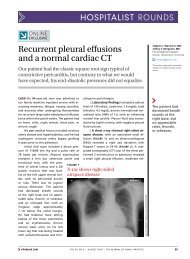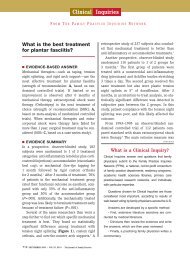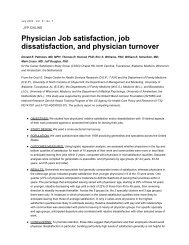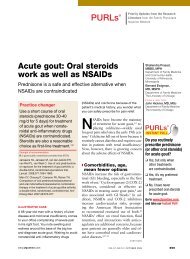Pruritic blisters on legs and feet - The Journal of Family Practice
Pruritic blisters on legs and feet - The Journal of Family Practice
Pruritic blisters on legs and feet - The Journal of Family Practice
Create successful ePaper yourself
Turn your PDF publications into a flip-book with our unique Google optimized e-Paper software.
photo by Wilfred luMbang, Md<br />
<str<strong>on</strong>g>Pruritic</str<strong>on</strong>g> <str<strong>on</strong>g>blisters</str<strong>on</strong>g> <strong>on</strong> <strong>legs</strong> <strong>and</strong> <strong>feet</strong><br />
Was recent outdoor fieldwork to blame for the pruritic<br />
<str<strong>on</strong>g>blisters</str<strong>on</strong>g> <strong>on</strong> this us navy sailor’s <strong>feet</strong> <strong>and</strong> calves?<br />
A<br />
23-year-old active duty US Navy<br />
sailor came to our medical center<br />
for treatment <strong>of</strong> 1–2 cm tense<br />
pruritic <str<strong>on</strong>g>blisters</str<strong>on</strong>g> <strong>on</strong> his dorsal <strong>feet</strong>, calves,<br />
<strong>and</strong> anterior lower extremities (FIGURE 1).<br />
He told us that several days earlier, he had<br />
noticed ill-defined “itchy red bumps” <strong>on</strong><br />
both <strong>legs</strong>. He denied fever, night sweats,<br />
malaise, trauma, insect bites, c<strong>on</strong>tact with<br />
animals or plants, or recent illnesses. He<br />
did say, however, that he’d recently d<strong>on</strong>e<br />
outdoor fieldwork with the Marine Corps<br />
in southern California.<br />
His medical history was unremarkable,<br />
<strong>and</strong> he was not taking any prescribed<br />
or over-the-counter medicati<strong>on</strong>s<br />
or supplements. He had no family history<br />
<strong>of</strong> blistering or other autoimmune<br />
disorders.<br />
On examinati<strong>on</strong>, we noticed clear<br />
fluid-filled vesicles <strong>and</strong> bullae <strong>on</strong> n<strong>on</strong>erythematous,<br />
n<strong>on</strong>-urticarial bases that<br />
were haphazardly distributed <strong>on</strong> both<br />
<strong>legs</strong> <strong>and</strong> dorsal <strong>feet</strong>. Agminated or herpetiform<br />
c<strong>on</strong>figurati<strong>on</strong>s were not present.<br />
Ruptured bullae left erythematous<br />
to beefy red eroded bases, <strong>and</strong> there were<br />
numerous smaller red papules with vesicular<br />
surface changes. All <strong>of</strong> the lesi<strong>on</strong>s<br />
were below the knees; there was complete<br />
sparing <strong>of</strong> the trunk, upper extremities,<br />
intertriginous skin, head, <strong>and</strong> neck.<br />
<strong>The</strong> remainder <strong>of</strong> the physical examinati<strong>on</strong><br />
was unremarkable, <strong>and</strong> there was<br />
no lymphadenopathy. Complete blood<br />
count <strong>and</strong> chemistries were within nor-<br />
www.jfp<strong>on</strong>line.com<br />
mal limits, <strong>and</strong> the patient’s HIV status<br />
was negative.<br />
We performed lesi<strong>on</strong>al <strong>and</strong> perilesi<strong>on</strong>al<br />
punch biopsies. <strong>The</strong> lesi<strong>on</strong>al<br />
biopsy dem<strong>on</strong>strated subepidermal blistering<br />
with a predominantly eosinophilic<br />
infiltrate in all layers <strong>of</strong> the dermis <strong>and</strong><br />
within the blister. Direct immun<strong>of</strong>luorescence<br />
(DIF) was performed <strong>on</strong> the<br />
perilesi<strong>on</strong>al biopsy <strong>and</strong> was negative for<br />
IgA, IgG, IgM, C3, <strong>and</strong> fibrinogen. Gram<br />
stain, potassium hydroxide (KOH) prep,<br />
<strong>and</strong> wound culture were also negative.<br />
z What is your diagnosis?<br />
figure 1<br />
Tense pruritic <str<strong>on</strong>g>blisters</str<strong>on</strong>g><br />
a 23-year-old active duty us navy sailor sought treatment<br />
for n<strong>on</strong>-erythematous pruritic <str<strong>on</strong>g>blisters</str<strong>on</strong>g> <strong>on</strong> his lower<br />
<strong>legs</strong> <strong>and</strong> dorsal <strong>feet</strong>. he had no lesi<strong>on</strong>s <strong>on</strong> his trunk,<br />
upper extremities, intertriginous skin, head, or neck.<br />
photo rounds<br />
Kendall Lane, MD, Lt, MC,<br />
USN <strong>and</strong> Wilfred Lumbang,<br />
MD, LCDR, MC, USN<br />
US Navy Medical Center,<br />
San Diego, Calif<br />
kendall.lane@navy.mil<br />
E D I t o R<br />
Richard p. Usatine, MD<br />
University <strong>of</strong> Texas Health<br />
Science Center at San Ant<strong>on</strong>io<br />
fast track<br />
All <strong>of</strong> the patient’s<br />
lesi<strong>on</strong>s were<br />
below the knees<br />
vol 57, no 3 / March 2008 177
photo rounds<br />
fast track<br />
<strong>The</strong> distributi<strong>on</strong><br />
<strong>of</strong> lesi<strong>on</strong>s <strong>and</strong> the<br />
lack <strong>of</strong> systemic<br />
illness are<br />
sufficient<br />
for diagnosis<br />
z Diagnosis:<br />
Bullous arthropod bite reacti<strong>on</strong><br />
Bullous arthropod bite reacti<strong>on</strong> (BABR)<br />
occurs in sensitized individuals as a delayed<br />
hypersensitivity immune reacti<strong>on</strong><br />
to insect saliva. 1 Patients typically present<br />
with grouped localized pruritic or<br />
asymptomatic blistering 2 <strong>and</strong> otherwise<br />
appear well. Unless sec<strong>on</strong>darily infected,<br />
the <str<strong>on</strong>g>blisters</str<strong>on</strong>g> are n<strong>on</strong>-erythematous <strong>and</strong><br />
n<strong>on</strong>-purulent, <strong>and</strong> develop within hours<br />
to days <strong>of</strong> the bite.<br />
lesi<strong>on</strong> locati<strong>on</strong> is key. <strong>The</strong> distributi<strong>on</strong><br />
<strong>and</strong> locati<strong>on</strong> <strong>of</strong> the lesi<strong>on</strong>s will tip<br />
you <strong>of</strong>f to a BABR diagnosis. <strong>The</strong> lesi<strong>on</strong>s<br />
in BABR are usually grouped <strong>and</strong> localized<br />
to a specific area <strong>of</strong> the body, depending<br />
<strong>on</strong> the causative arthropod <strong>and</strong><br />
the circumstances leading to the bites.<br />
For example:<br />
• lesi<strong>on</strong>s caused by Cheyletiella mites<br />
are typically found <strong>on</strong> the forearms, anterior<br />
thighs, <strong>and</strong> lower abdomen after an<br />
infested pet sits <strong>on</strong> an individual’s lap. 2,3<br />
• Blisters caused by flea bites are isolated<br />
to the lower extremities. 4 (We suspect<br />
that flea bites were the culprit in our<br />
patient’s case.)<br />
• lesi<strong>on</strong>s caused by Cimex lectularius,<br />
more comm<strong>on</strong>ly known as bedbugs, may<br />
be found <strong>on</strong> the entire body <strong>and</strong> tend to<br />
occur in groups <strong>of</strong> 3. 5<br />
Insect bite?<br />
What insect bite?<br />
Most patients will <strong>on</strong>ly complain <strong>of</strong> pruritus<br />
<strong>and</strong> will tell you that they d<strong>on</strong>’t<br />
recall having had any insect bites. 6 That<br />
said, the distributi<strong>on</strong> <strong>of</strong> the lesi<strong>on</strong>s, lack<br />
<strong>of</strong> systemic illness, <strong>and</strong> otherwise unremarkable<br />
physical exam are sufficient for<br />
diagnosis.<br />
Occasi<strong>on</strong>ally, a punch biopsy with<br />
DIF may be necessary to rule out more<br />
serious bullous disorders. In BABR, you<br />
may see both subepidermal <strong>and</strong> intraepidermal<br />
blistering, with perivascular <strong>and</strong><br />
interstitial eosinophilic <strong>and</strong> lymphocytic<br />
infiltrates. Blisters separated by str<strong>and</strong>s<br />
<strong>of</strong> keratinocytes create a characteristic<br />
178 vol 57, no 3 / March 2008 <strong>The</strong> <strong>Journal</strong> <strong>of</strong> family PracTice<br />
multilocular appearance. Unlike autoimmune<br />
blistering disorders, DIF is negative<br />
in BABR. 7 Gram stain, Tzanck smear,<br />
bacterial culture, <strong>and</strong> KOH prep may<br />
also provide additi<strong>on</strong>al informati<strong>on</strong> if infecti<strong>on</strong><br />
is a c<strong>on</strong>cern.<br />
For certain patients,<br />
the DX may be less clear-cut<br />
Similar bullous lesi<strong>on</strong>s following insect<br />
bites have been reported in patients with<br />
HIV, 8 chr<strong>on</strong>ic lymphocytic leukemia, 9–12<br />
EBV-associated Natural Killer leukemia/<br />
lymphoma, 13 <strong>and</strong> mantle cell lymphoma. 14<br />
<strong>The</strong>re is <strong>on</strong>going debate as to whether the<br />
vesicular lesi<strong>on</strong>s in these patients truly<br />
represent an exaggerated resp<strong>on</strong>se to an<br />
arthropod bite or mimic an insect-like bite<br />
reacti<strong>on</strong>. 10,12<br />
Nevertheless, when you suspect a patient<br />
has BABR, be aware <strong>of</strong> its associati<strong>on</strong><br />
with both hematologic malignancies<br />
<strong>and</strong> HIV. Appropriate evaluati<strong>on</strong>, such as<br />
HIV screening <strong>and</strong> complete blood count,<br />
should be performed.<br />
A c<strong>on</strong>diti<strong>on</strong> that mimics<br />
c<strong>on</strong>tact dermatitis<br />
Clinically <strong>and</strong> histologically, BABR can<br />
mimic the following:<br />
• c<strong>on</strong>tact dermatitis. With c<strong>on</strong>tact<br />
dermatitis, the blistering is more likely to<br />
appear in streaks or in a linear fashi<strong>on</strong>. 15<br />
Lesi<strong>on</strong>s will be painful, as well as pruritic,<br />
<strong>and</strong> occur following direct c<strong>on</strong>tact with a<br />
plant or chemical allergen.<br />
• Drug-induced pemphigoid. <strong>The</strong><br />
patient’s history will increase your suspici<strong>on</strong><br />
<strong>of</strong> drug-induced pemphigoid. Patients<br />
may be taking sulfur-c<strong>on</strong>taining<br />
drugs (furosemide), antibiotics (penicillins,<br />
fluoroquinol<strong>on</strong>es), antihypertensives<br />
(ACE inhibitors, calcium channel blockers),<br />
neuroleptics, or sulfasalazine. 7,16,17<br />
<strong>The</strong> erupti<strong>on</strong> is usually more generalized<br />
than BABR, <strong>and</strong> may involve the mucous<br />
membranes.<br />
• fungal infecti<strong>on</strong>s. <strong>The</strong>se infecti<strong>on</strong>s<br />
will typically occur <strong>on</strong> the palms <strong>and</strong>
soles. Infiltrate is typically neutrophilic,<br />
but can be eosinophilic. 18<br />
• Bullous scabies. Patients will have<br />
severe pruritus. Burrows <strong>and</strong> lesi<strong>on</strong>s can<br />
typically be found <strong>on</strong> moist areas (periumbilical,<br />
intertriginous skin). 19,20<br />
• Bullous pemphigoid. This is more<br />
comm<strong>on</strong>ly seen in elderly patients with<br />
comorbid c<strong>on</strong>diti<strong>on</strong>s. Onset <strong>of</strong> blistering<br />
is gradual, <strong>and</strong> occurs predominantly <strong>on</strong><br />
flexural skin.<br />
Pemphigoid gestati<strong>on</strong>is, erythema<br />
toxicum ne<strong>on</strong>atorum, inc<strong>on</strong>tinentia pigmenti,<br />
<strong>and</strong> some pemphigus variants also<br />
have predominantly eosinophilic infiltrati<strong>on</strong><br />
in the skin. <strong>The</strong>se, however, are clinically<br />
distinct from BABR.<br />
z Focus <strong>on</strong> symptoms<br />
<strong>and</strong> preventi<strong>on</strong><br />
BABR will resolve over time without aggressive<br />
interventi<strong>on</strong>. Most patients are<br />
treated symptomatically with oral antihistamines<br />
<strong>and</strong> topical steroids for pruritus.<br />
1 Preventi<strong>on</strong> <strong>of</strong> further bites is important<br />
because <strong>of</strong> the risk <strong>of</strong> arthropodtransmitted<br />
diseases. 21<br />
Our patient couldn’t<br />
comfortably wear shoes<br />
Our patient had extensive tense blistering<br />
<strong>on</strong> both <strong>legs</strong> that prevented him from<br />
comfortably wearing shoes (FIGURE 2). Using<br />
a #11 blade, we punctured all <strong>of</strong> the<br />
<str<strong>on</strong>g>blisters</str<strong>on</strong>g> at the most dependent porti<strong>on</strong> <strong>of</strong><br />
each lesi<strong>on</strong>. We decompressed the lesi<strong>on</strong>s,<br />
but did not de-ro<strong>of</strong> them so that the blistered<br />
skin could serve as a biological<br />
dressing. We applied topical mupirocin<br />
<strong>and</strong> wrapped both <strong>legs</strong> with a compressive<br />
dressing.<br />
We gave the patient a 2-week tapering<br />
course <strong>of</strong> oral prednis<strong>on</strong>e. At the 3week<br />
follow-up, all <strong>of</strong> the blistered skin<br />
had completely healed with the excepti<strong>on</strong><br />
<strong>of</strong> post-inflammatory hyperpigmentati<strong>on</strong>.<br />
No new lesi<strong>on</strong>s developed. Our<br />
patient was well, with no recurrence <strong>of</strong><br />
blistering, at his 6-m<strong>on</strong>th follow-up. n<br />
www.jfp<strong>on</strong>line.com<br />
figure 2<br />
Wearing shoes was a problem<br />
our patient's extensive tense blistering precluded him<br />
from comfortably wearing shoes. We punctured <strong>and</strong><br />
decompressed the lesi<strong>on</strong>s, but did not de-ro<strong>of</strong> them.<br />
the blistered skin served as a biological dressing.<br />
corresp<strong>on</strong>dence<br />
Kendall lane, Md, expediti<strong>on</strong>ary health services pacific,<br />
3985 cummings rd, suite 4, san diego, ca 92136;<br />
kendall.lane@navy.mil<br />
Disclosure<br />
the authors reported no potential c<strong>on</strong>flict <strong>of</strong> interest relevant<br />
to this article. the views expressed in this article<br />
are those <strong>of</strong> the authors <strong>and</strong> do not reflect the <strong>of</strong>ficial<br />
policy or positi<strong>on</strong> <strong>of</strong> the department <strong>of</strong> the navy, department<br />
<strong>of</strong> defense, or the united states government.<br />
references<br />
1. north american arthropod envenomati<strong>on</strong> <strong>and</strong> parasitism.<br />
in: auerbach ps, ed. Wilderness Medicine.<br />
5th ed. philadelphia, pa: Mosby; 2007:947–982.<br />
2. bjarke t, hellgren l, orstadius K. cheyletiella parasitivorax<br />
dermatitis in man. Acta Derm Venereol<br />
1973; 53:217–224.<br />
3. shelley ed, shelley Wb. the diagnostic challenge<br />
<strong>of</strong> n<strong>on</strong>burrowing mite bites cheyletiella yasguri.<br />
JAMA 1984; 251:2690–2691.<br />
4. infestati<strong>on</strong>s <strong>and</strong> bites. in: habif tp. Clinical Dermatology:<br />
A Color Guide to Diagnosis <strong>and</strong> Treatment.<br />
4th ed. st louis, Mo: Mosby; 2004:533–534.<br />
5. elst<strong>on</strong> dM, stockwell s. What’s eating you? bedbugs.<br />
Cutis 2000; 65:262–264.<br />
6. steen c, carb<strong>on</strong>aro p, schwartz r. arthropods in<br />
dermatology. J Am Acad Dermatol 2004; 50:819–<br />
842.<br />
7. the vesiculobullous reacti<strong>on</strong> pattern. in: Weed<strong>on</strong><br />
d. Skin Pathology. 2nd ed. brisbane, australia:<br />
churchill livingst<strong>on</strong>e; 2002:129–191.<br />
8. ajithkumar K, soshamma g, george, b. abnormal<br />
insect bite reacti<strong>on</strong>s: a manifestati<strong>on</strong> <strong>of</strong> immunosuppressi<strong>on</strong><br />
<strong>of</strong> hiv infecti<strong>on</strong>? Indian J Dermatol<br />
Venereol Leprol 2001; 67:72–74.<br />
9. davis Md, perniciaro c, dahl pr, r<strong>and</strong>le hW,<br />
pruritic <str<strong>on</strong>g>blisters</str<strong>on</strong>g> <strong>on</strong> <strong>legs</strong> <strong>and</strong> <strong>feet</strong><br />
fast track<br />
Treatment<br />
centers<br />
<strong>on</strong> oral<br />
antihistamines<br />
<strong>and</strong> topical<br />
steroids<br />
for pruritus<br />
vol 57, no 3 / March 2008 179
photo rounds<br />
Mcevoy Mt, leiferman KM. exaggerated arthropod-bite<br />
lesi<strong>on</strong>s in patients with chr<strong>on</strong>ic lymphocytic<br />
leukemia: a clinical, histopathologic, <strong>and</strong> immunopathologic<br />
study <strong>of</strong> eight patients. J Am Acad<br />
Dermatol 1998; 39:27–35.<br />
10. pendersen J, carganello J, van der Weyden Mb.<br />
exaggerated reacti<strong>on</strong> to insect bites in patients<br />
with chr<strong>on</strong>ic lymphocytic leukemia: clinical <strong>and</strong><br />
histological findings. Pathology 1990; 22:141–143.<br />
11. rosen lb, frank bl, rywlin aM. a characteristic<br />
vesticulobullous reacti<strong>on</strong> in patients with chr<strong>on</strong>ic<br />
lymphocytic leukemia. J Am Acad Dermatol 1986;<br />
15:943–950.<br />
12. barzilai a, shpiro d, goldberg i, et al. insect bitelike<br />
reacti<strong>on</strong> in patients with hematologic malignant<br />
neoplasms. Arch Dermatol 1999; 135:1503–1507.<br />
13. tokur y, ishihara s, tagawa s, et al. hypersensitivity<br />
to mosquito bites as the primary clinical<br />
manifestati<strong>on</strong> <strong>of</strong> juvenile type <strong>of</strong> epstein-barr virusassociated<br />
natural killer cell leukemia/lymphoma.<br />
J Am Acad Dermatol 2001; 45:569–578.<br />
14. Khamaysi Z, dodiuk-gad rp, Weltfriend s, et al.<br />
insect bite-like reacti<strong>on</strong> associated with mantle cell<br />
lymphoma: clinicopathological, immunopathological,<br />
<strong>and</strong> molecular studies. Am J Dermatopathol<br />
2005; 27:290–295.<br />
15. allergic c<strong>on</strong>tact dermatitis. in: habif tp. Clinical<br />
Dermatology: A Color Guide to Diagnosis <strong>and</strong><br />
Treatment. 4th ed. st louis, Mo: Mosby; 2004:84–<br />
97.<br />
16. Kimyai-asadi a, usman a, nousari hc. cipr<strong>of</strong>loxacin-induced<br />
bullous pemphigoid. J Am Acad Dermatol<br />
2000; 42:847.<br />
17. Kashihara M, danno K, Miyachi y, horiguchi y,<br />
imamura s. bullous pemphigoid-like lesi<strong>on</strong>s induced<br />
by phenacetin. report <strong>of</strong> a case <strong>and</strong> an<br />
immunopathologic study. Arch Dermatol 1984;<br />
120:1196–1199.<br />
18. Mycoses <strong>and</strong> algal infecti<strong>on</strong>s. in: Weed<strong>on</strong> d. Skin<br />
Pathology. 2nd ed. brisbane, australia: churchill<br />
livingst<strong>on</strong>e; 2002: 663.<br />
19. nakamura, e. taniguchi, h. ohtaki n. a case <strong>of</strong><br />
crusted scabies with a bullous pemphigoid-like<br />
erupti<strong>on</strong> <strong>and</strong> nail involvement. J Dermatol 2006;<br />
33:196–201.<br />
20. ansarin h, Jalali Mh, Mazloomi s, soltani-arabshahi<br />
r, setarehshenas r. scabies presenting with<br />
bullous pemphigoid-like lesi<strong>on</strong>s. Dermatol Online J<br />
2006;12(1):19.<br />
21. elst<strong>on</strong> d. preventi<strong>on</strong> <strong>of</strong> arthropod-related disease.<br />
J Am Acad Dermatol 2004; 947–954.<br />
Visit the <strong>Journal</strong> <strong>of</strong> <strong>Family</strong> practice<br />
<strong>on</strong>line at: www.JfP<strong>on</strong>line.com








